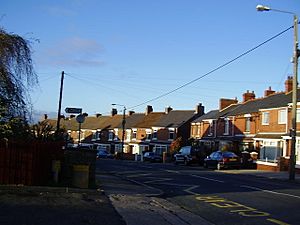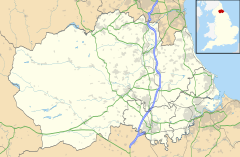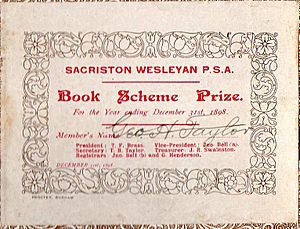Sacriston facts for kids
Quick facts for kids Sacriston |
|
|---|---|
 Main road through Sacriston |
|
| Population | 4,999 2011 census |
| OS grid reference | NZ240470 |
| Unitary authority |
|
| Ceremonial county | |
| Region | |
| Country | England |
| Sovereign state | United Kingdom |
| Post town | DURHAM |
| Postcode district | DH7 |
| Dialling code | 0191 |
| Police | Durham |
| Fire | County Durham and Darlington |
| Ambulance | North East |
| EU Parliament | North East England |
| UK Parliament |
|
Sacriston is a village in County Durham, England. It is about 3 miles north of the city of Durham. Sacriston has been home to people since the Bronze Age. It is also a civil parish and an electoral ward.
Contents
Exploring Sacriston's Past
How Old is Sacriston?
People have lived in the Sacriston area since the Bronze Age. The first recorded settlement was in the 13th century. It was called Sacristan's Heugh. Locals now call it "Segga."
This farm and manor house was once home to the Sacristan. A Sacristan was a monk from Durham Cathedral. This monk was in charge of getting everything ready for church services. This included bread, wine, and special clothes called vestments. The Sacristan also made sure the cathedral was repaired. Money for these duties came from the Sacristan's Heugh estate. The old house was taken down after World War II.
Sacriston's Mining Story
Coal mining became a big part of Sacriston's history. The Sacriston Colliery (coal mine) started in 1838. By the 1890s, about 600 men worked there. They produced 1,000 tons of coal every day. A Wesleyan chapel was built in 1865. In the early 1870s, the village had over 2,100 people. Many of them worked in the mines.
The 1903 Mine Accident
On November 16, 1903, water suddenly flooded a part of the mine. This tragic event killed two miners, John Whittaker and Thomas McCormick. Another miner, Robert Richardson, was found alive days later. He had been trapped in the dark for 92 hours.
An investigation was held, and it was decided that the accident was not the fault of the mine managers. Six mine officials were given silver medals for their actions. However, some miners later felt that the full story might not have been told. Years later, workers found the bones of a pit pony that died in the flood. They also found a full tub of coal with a miner's token. The miner then received his pay for that coal.
The 1940 Mine Accident
Another sad event happened on December 4, 1940. A large amount of rock fell in one of the work areas. This accident killed five miners:
- Joseph Welsh, 46
- George W. Scott, 39
- William Richardson, 50
- William Smith, 40
- John William Britton, 47
The End of Mining
Over time, the best coal seams became empty. By 1979, the mine was producing much less coal. The last coal was mined on November 15, 1985. The colliery officially closed on December 28, 1985.
When the mine closed, many people lost their jobs. This caused social problems in the village. Today, there is little left of the old mining operations. The area around the mine has been turned into woodland. Some old mining buildings still stand. One is now used by the local council for refuse vehicles. Sacriston Wood is now a 30-hectare local nature reserve.
How Sacriston is Governed
Sacriston is an electoral ward. This means it has its own local government representatives. In 2011, the total population of this ward was 6,613 people.
Life in Sacriston Today
Even though the coal mine closed many years ago, Sacriston still has a strong community spirit. A new community center has opened, helping the village move forward.
Sacriston has many shops for its size. These include mini-marts, a greengrocer, and a newsagent. There are also barber shops, takeaway restaurants, and more. The village has two social clubs and a cricket club. There is also one public house remaining.
Learning in Sacriston
The village has two schools. One is a Roman Catholic primary school. The other is Sacriston Academy. Sacriston Academy opened on September 1, 2014. It combined an infant school and a junior school.
Sacriston used to have a secondary school called Fyndoune Community College. This school closed in 2021. Another infant school, Plawsworth Road Infant School, closed in 2013. Houses have since been built on its site.
Public Services in Sacriston
A new health center opened in 2008. It includes a dental practice and a doctor's surgery. The famous football manager Sir Bobby Robson officially opened it. This center was built where the village's old swimming baths used to be. The swimming baths closed in the 1990s.
In 2009, the Northern Integrative Health Practice (NIHP Sacriston Practice) opened. It offers services that work alongside traditional healthcare. This building also became an out-patients center for Sunderland Eye Infirmary in 2010.
Famous People from Sacriston
Sacriston has been home to several notable people:
- Melvyn Betts (born 1975) – A former cricketer for Durham, Warwickshire, and Middlesex.
- Ian Hunter (cricketer) (born 1979) – A former Durham cricketer, now playing for Derby. He went to Fyndoune Community College in Sacriston.
- Wendy Craig (born 1934) – A well-known English actress.
- Sir Bobby Robson (1933–2009) – A famous football player and manager.
- Kevan Jones (born 1964) – The Member of Parliament for the area. He lives in Sacriston and has his office there.



